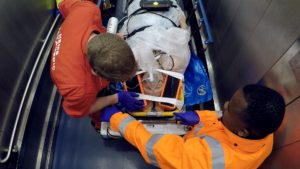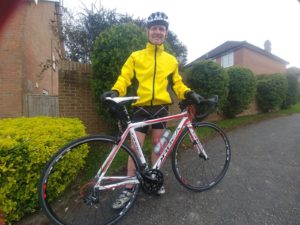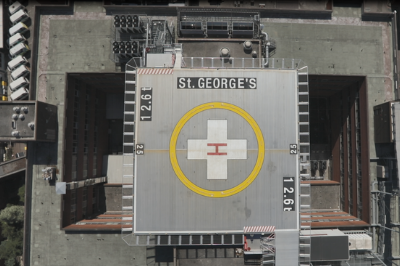St George’s celebrates helipad fifth anniversary
St George’s celebrates five years since the official launch of its helipad this month.
The helipad at St George’s was officially opened on 29 May 2014, after having been operationally open since 7 April 2014, by former Mayor of London Boris Johnson.
Five air ambulance providers have brought a total of 783 critically ill or injured patients to St George’s and there have been 1323 helipad landings overall*.
Planning for the helipad started in 2010 shortly after St George’s was named as the designated major trauma centre for the South West London and Surrey Trauma Network.
It was the first to open in south London, took 11 months to construct and cost £5m with the Helicopter Emergency Landing Pad (HELP) appeal donating £1m to its construction.
In 2018, the HELP appeal donated an additional £400,000 to install a deck integrated firefighting system which is able to extinguish a fire quickly and effectively, therefore protecting the helipad and hospital, ensuring the safety of those on deck and avoiding the need for a hospital evacuation.
Dr Anthony Hudson, Clinical Director for Major Trauma and Emergency Medicine Consultant at St George’s, said: “Having the helipad at St George’s has proved hugely beneficial to our patients who are brought here in life-threatening conditions.
He added: “As one of London’s four major trauma centres, we know that getting patients to us in the fastest time possible so they can receive expert care from our major trauma teams is vital for ensuring the best survival rates and future quality of life.”
Robert Bertram, Chief Executive of the HELP Appeal said: “St George’s was the first hospital helipad in London to be funded by the charity. It was also the first hospital helipad to be built south of the River Thames. Since 2014, this helipad has given seriously ill patients flying into St George’s the best possible chance of survival as they have immediate access to the emergency department after landing.”
Martin Henderson was airlifted to St George’s by Kent, Surrey and Sussex Air Ambulance after he crashed into a cliff while paragliding which left him with multiple leg and spine fractures, a dislocated hip and spinal cord damage.
Photo: The Garden Productions
Martin, a former soldier in the third battalion of the parachute regiment, received urgent life-changing emergency care upon arrival at St George’s.
He underwent surgery and was then taken to neuro intensive care, where he was placed in a coma for eight days. Seven weeks later, Martin took his first steps.
Being airlifted to St George’s, as opposed to being transferred by road ambulance, was essential to Martin’s survival and recovery as any slight movement carried a high risk of leaving him paralysed.
Being in a major trauma centre also meant he benefitted from our specialist teams from the emergency department through to the surgical and intensive care teams, and later the ward and rehabilitation teams too.
Martin said: “I can’t thank the HELP Appeal enough. The whole package – the air ambulance, helipad and hospital, saved my life.
He added: “The helipad ensured that I was delivered into the right hands promptly, which can only be a good thing. Any delay in treatment could have been detrimental to my health and the final outcome.
He added: “The flight took just seven minutes from the crash site to the hospital. This speed would not have been possible in a road ambulance.
Photo: Martin Henderson
Since his recovery, Martin has returned to physical activities and has taken part in triathlons
You can watch Martin’s story – which was shown on 24 Hours in A&E and produced by The Garden Productions for Channel 4 on 15 August 2018 – by visiting the All 4 website here: https://www.channel4.com/programmes/24-hours-in-ae/on-demand/65066-014
More about the HELP appeal: https://helpappeal.org.uk/
Notes to editors
*Dates correct up to 21 May 2019
1000th HEMS landing since opening took place on 1 April 2018.
For more information, please contact Pippa Harper, Media Manager, via 020 8266 6128 or philippa.harper@stgeorges.nhs.uk




